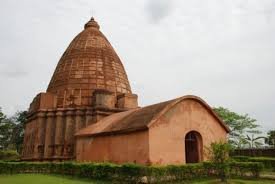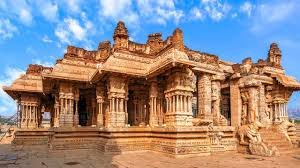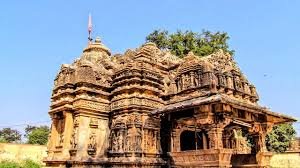Nestled in the historic town of Sivasagar, Assam, Devi Dol is one of the most revered Shakti temples in the region. Dedicated to Goddess Durga, this magnificent temple stands as a testament to the architectural brilliance and religious devotion of the Ahom dynasty. Built in the 18th century, alongside Sivadol and Vishnudol, Devi Dol continues to attract pilgrims, history enthusiasts, and travelers from across India.
This blog explores the history, architecture, religious significance, grand festivals, and travel tips to help you experience the spiritual and cultural essence of Devi Dol.
Historical Legacy of Devi Dol
Built During the Ahom Era
The Ahom dynasty, which ruled Assam for over 600 years, was known for its patronage of temples and monuments. Queen Ambika, the wife of Swargadeo Siva Singha, constructed Devi Dol in 1734 AD, along with Sivadol and Vishnudol, near the sacred Sivasagar Tank.
The temple was dedicated to Goddess Durga, the embodiment of Shakti (divine feminine power), who is worshipped as the protector of the universe. Over the centuries, Devi Dol has remained a vital center for Durga worship and tantric rituals, drawing devotees seeking blessings for strength, protection, and prosperity.
Architectural Marvel of Devi Dol
The structural beauty of Devi Dol reflects a blend of Ahom and North Indian temple architecture. Built with stone and brick, the temple features a unique dome-like structure (Shikhara), characteristic of Ahom-era temples.
Key Architectural Highlights
- Towering Shikhara (Temple Spire) – The imposing dome-shaped spire, adorned with intricate carvings, rises high, symbolizing divine connection with the heavens.
- Massive Walls and Sculptures – The temple’s stone walls are decorated with carvings of Hindu gods, goddesses, and mythological motifs, showcasing exceptional craftsmanship.
- Sacred Inner Sanctum (Garbhagriha) – The sanctum houses a grand idol of Goddess Durga, worshipped with elaborate rituals and offerings.
- Temple Complex – The temple stands near the holy Sivasagar Tank, alongside Sivadol and Vishnudol, forming a sacred trinity of temples.
The aesthetic brilliance and divine aura of Devi Dol make it a must-visit for devotees and history lovers alike.
Spiritual and Religious Significance
Devi Dol is one of Assam’s most important Shakti temples, revered by followers of Hinduism, particularly Shaktism. Devotees believe that Goddess Durga, worshipped as Mahishasuramardini (the Slayer of the Demon Mahishasura), bestows strength, courage, and protection upon her devotees.
Sacred Rituals and Offerings
- Daily Puja and Aarti – The temple priests perform morning and evening aartis, creating a spiritually uplifting atmosphere.
- Kumari Puja – Young girls, symbolizing the living goddess, are worshipped as part of Shakti rituals.
- Chandi Path – Special recitations from the Durga Saptashati (Chandi Path) are conducted to invoke the divine energy of Goddess Durga.
- Animal Sacrifices (Earlier Tradition) – Though no longer widely practiced, Devi Dol historically had ritualistic animal sacrifices as an offering to the goddess.
These traditions reflect the deep-rooted devotion and spiritual significance of the temple.
Grand Festivals Celebrated at Devi Dol
The temple is especially vibrant during festivals, with thousands of devotees, cultural performances, and spiritual discourses making it a center of devotion and celebration.
1. Durga Puja: The Biggest Festival
- Celebrated in September-October, Durga Puja is the grandest festival at Devi Dol.
- The temple is beautifully decorated with flowers and lights, creating a festive ambiance.
- Devotees participate in prayers, bhajans, and special rituals, honoring the nine forms of Goddess Durga.
- The Kanya Puja and Sindoor Khela (where married women apply vermilion) mark the culmination of celebrations.
2. Navaratri Celebrations
- The temple observes Navaratri, a nine-day festival dedicated to Goddess Durga, with great devotion.
- Special Durga Saptashati recitations, fasting, and night-long bhajans take place.
- The festival ends with Vijaya Dashami, symbolizing victory of good over evil.
3. Kali Puja and Diwali
- Diwali, the festival of lights, adds to the spiritual grandeur, with lamps and candles illuminating the temple.
4. Magh Bihu and Sankranti Celebrations
- During Magh Bihu (January) and Makar Sankranti, special prayers and community feasts take place at the temple.
These festivals bring together devotees and tourists, making Devi Dol a hub of cultural and spiritual vibrancy.
How to Reach Devi Dol
- The nearest airport is Jorhat Airport (JRH), around 75 km away.
- From Jorhat, one can hire taxis or take buses to Sivasagar
- The closest railway station is Simaluguri Junction, 16 km from Sivasagar.
- Regular trains from Guwahati, Dibrugarh, and other major cities connect to Sivasagar.
Nearby Attractions in Sivasagar
Sivasagar is rich in history and heritage. While visiting Devi Dol, travelers can explore:
- Sivadol – The tallest Shiva temple in India, located near Devi Dol.
- Vishnudol – A temple dedicated to Lord Vishnu, completing the sacred trio of temples.
- Rang Ghar – The oldest surviving amphitheater in Asia, used for Ahom royal entertainment.
- Talatal Ghar – A grand Ahom palace with underground tunnels.
- Sivasagar Tank – A serene water body, built by the Ahoms, offering a peaceful retreat.
Conclusion: A Divine and Cultural Treasure
Devi Dol, Sivasagar, is not just a temple, but a sacred legacy of faith, history, and architectural grandeur. As one of Assam’s most significant Shakti temples, it draws devotees, historians, and travelers alike, offering an immersive experience of devotion and heritage.
If you seek spiritual enlightenment, historical insights, or cultural richness, Devi Dol is a must-visit. Witness the divine power of Goddess Durga and immerse yourself in the spiritual aura of this magnificent temple. 🙏✨





